Crimson Trace Master Series Lasergrips: Lifesaving Technology Made from…Wood?
Tom McHale 08.06.13
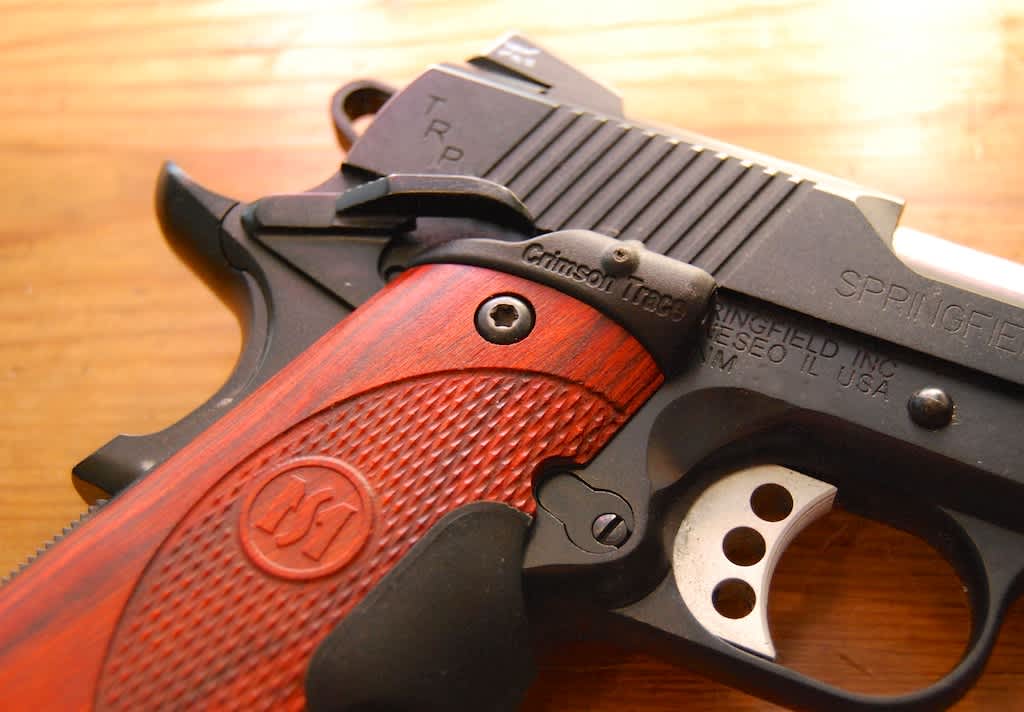
Wood is an amazing construction material. It’s renewable, looks great, feels even better, and makes a handgun look really dapper, dandy, and dashing.
Did you know that:
- Redwood bark can be up to 24 inches thick.
- Each year, the average American “consumes” enough wood to fill the cargo area of 4.11 AMC Gremlins, assuming you fold down the seats.
- Wood, when converted to paper at the Mead-Westvaco paper plant in Charleston, South Carolina, is really, really smelly.
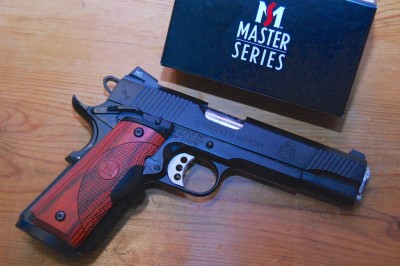
With all these nifty qualities, why is the industry steadily moving towards more plastic, and fewer wood offerings? Yeah, I know. Plastic is inexpensive, easy to manufacture and durable. But, but, but…wood!
Enter the Crimson Trace Master Series Lasergrips.
Available in G10 composite, walnut, and rosewood, the Master Series Lasergrips are the Cadillacs of the Crimson Trace offerings.
Today, we’ll take a look at the Crimson Trace Master Series Lasergrips in rosewood for the full-size 1911 pistol.
Rosewood, or the more familiar term, Dalbergia cochinchinensis, comes from mountainous regions in the Far East. It’s not only beautiful to look at, but features high bending and crushing strength and good resistance to shock. Not bad qualities for use on a gun, right? Most importantly, rosewood is moderately resistant to termites, which is an important consideration for use on high-end pistols like the Springfield Armory TRP 1911 featured here. I’ve had a dickens of a time trying to clear the termite infestations from my IWB holsters.
Crimson Trace impregnates rosewood laminate layers with resin to add even more strength and durability. While not as damage resistant as G10, these grips are designed to be tougher than standard wooden grips. They’ve certainly proven themselves tough enough for carry. I’ve been using this configuration daily for the past six months, and there is no sign of wear or damage. In the interest of thorough testing, I’ll keep trying.
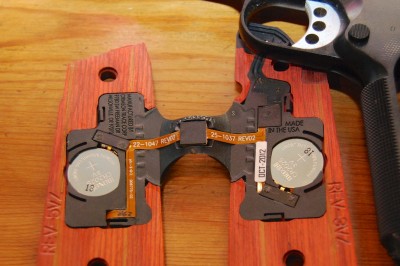
You might wonder how Crimson Trace manages to make fancy electronics from wood. That’s a great question. Think of these grips as carefully carved wood packaging around the electrical and laser components. You’ll see that the underside of the grip panels feature perfectly carved channels for batteries, wiring, and the laser assembly itself. The only visible parts of the grips not made from rosewood are the black laser housing at the top of the right grip panel and the activation button that crosses the front strap.
Like most other Crimson Trace Lasergrip offerings, this kit included everything needed for installation–even batteries!
The only things not included are the grip screws. The idea is to use the ones already on your pistol to mount the Lasergrips. If your 1911 pistol came without grips, you got a really bad deal. But that’s another story.
The required batteries are CR2025 type, meaning they are readily available at most any grocery, drug, or housewares store. A pair of two, one housed in each grip panel, will get you four hours of continuous use. Going to the range to practice? No worries, the Master Series Lasergrips feature a positive On/Off slide switch on the left panel, so you can easily deactivate the laser to save battery life.
Like most other Crimson Trace Lasergrips, these feature instinctive activation. In this case, the activation button is on the front of the grip, just below the trigger guard. With a normal firing grip, your middle finger will activate the laser without extra user intervention.
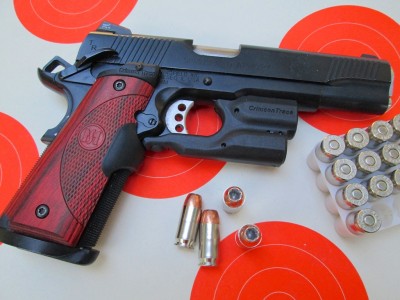
The neatest part? The Crimson Trace Lightguard for 1911s are compatible with this laser. The 1911 Lightguard model has its activation button on the bottom of the trigger guard, so the side of your middle finger activates the light. Without conscious effort, your firing grip will activate both light and laser.
I’ve gotten completely spoiled with the Lasergrip and Lightguard combination and currently have the Springfield Armory TRP shown here configured that way. The only problem? Holsters! Help! I need to find a really nice inside the waistband holster that will accommodate the 1911 with a Lightguard attached. The Master Series Lasergrips show here are compatible with any standard 1911 holster.
Installation is a snap.
First, make sure your gun is unloaded. Really unloaded. Remove the magazine. Now rack the slide 1,479 times in succession, verifying each time that the chamber is empty.
Next, carefully remove the existing grip panels. Here’s a great opportunity to invest in some real gunsmithing screwdrivers and bits. Made properly with flat group tips, unlike the standard hardware store versions, they won’t butch up the screws on your nice pistol. When you remove the existing grip panels, you’ll probably find a great spring cleaning opportunity. Go ahead, take advantage!
Install the included batteries in the Lasergrip panels, being careful to follow the directions about which way the positive and negative sides go. Before attaching the new grips, place the included dust shields between the grip panels and gun frame.
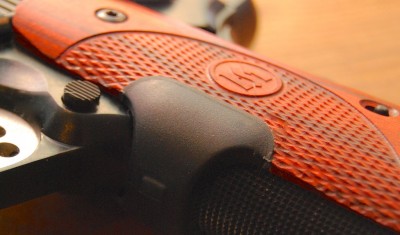
That’s it! You’ll almost certainly find that the laser is more or less on target right off the bat, but if it’s not, no worries. The Lasergrips include windage and elevation adjustments along with a handy tool to make those tweaks.
Here’s where you have a choice to make. Since the laser is maybe three-fourths of an inch from the center of the bore, you can align the laser beam exactly parallel to the bore and still be pretty much on target. This will cause the bullet to impact about three-fourths of an inch low and to the right–not counting bullet drop at greater distances of course. Or, you can choose a distance where the flight of the bullet will converge with the laser beam. Many folks will adjust the laser to converge with point of impact at an “indoor” distance like 25 feet. If you choose the convergence method, just be aware that at distances closer than your zero range, the bullet will impact low-right. Beyond the zero distance, the impact will be high-left–but not very much. The decision is totally up to you.
Bottom line on the Crimson Trace Master Series Lasergrips? You can have functionality, durability AND good looks!

